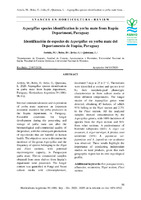Aspergillus species identification in yerba mate from Itapúa Department, Paraguay
Identificación de especies de Aspergillus en yerba mate del Departamento de Itapúa, Paraguay
Date
2020-12-20Author
Arriola Almada, Manuela
Bohn Amaro, Daysi
Jerke, Gladis
Quintana Viedma, Lidia Augusta
Metadata
Show full item recordAbstract
Internal commercialization and exportation of yerba mate represent an important economic incentive for yerba producers in the Itapúa department, in Paraguay. Favorable conditions For fungal development during the processing and storage of yerba mate can alter the bromatological and commercial quality of the product, with the consequent production of mycotoxins that are harmful to human health. The objectives were to determine the incidence of the genus Aspergillus and the frequency of species belonging to the Nigri and Flavi sections, with potential mycotoxigenic capacity, in Paraguayan yerba mate. Eleven commercial simples obtained from store shelves from Itapúa´s department were processed. The fungal content was quantified in Fungi and Yeast culture media with chloramphenicol, incubated 7 days at 25 ± 2 ° C. The isolates were identified at section and species level by their morphological phenotypic characteristics in three culture media at three different temperatures. The fungal strains of the Aspergillus genus were detected, obtaining 43 isolates, of which 95% belong to the Nigri section and 2.7% to the Flavi section. All the analyzed simples showed contamination by the Aspergillus genera, with 100% incidence of species from the Nigri section and 36% from other sections. A predominance of biseriate subspecies (66%) A. niger var awamori, A. niger var niger, A. fetidus, over uniseriate (34%) A. japonicus var. japonicus and A. japonicus var aculeatus was observed. These results highlight the importance of conducting independent studies on local products, given that each geographic region has its own mycological profile. La comercialización interna y la exportación de la yerba mate representan un incentivo económico importante para productores yerbateros del Departamento de Itapúa, Paraguay. Condiciones favorables para el desarrollo fúngico durante el procesamiento y almacenado de la yerba mate pueden alterar la calidad bromatológica y comercial del producto, con la consecuente producción de micotoxinas perjudiciales para la salud humana. Los objetivos fueron determinar la incidencia del género Aspergillus y la frecuencia de especies pertenecientes a las secciones Nigri y Flavi, con potencial capacidad micotoxicogénica, en yerba mate de origen paraguayo. Se procesaron 11 muestras comerciales obtenidas de comercios del departamento de Itapúa. El contenido fúngico fue cuantificado en medio de cultivo Hongos y Levaduras con cloranfenicol, incubadas 7 días a 25±2 °C. Los aislados fueron identificados a nivel secciones y especies por sus características fenotípicas morfológicas en tres medios de cultivo a tres temperaturas diferentes. Se detectan las cepas fúngicas del género Aspergillus, obteniéndose 43 aislados, de los cuales el 95% pertenece a la sección Nigri y 2,7% a la sección Flavi. Todas las muestras analizadas mostraron contaminación por el género Aspergillus, con 100% de incidencia de especies de la sección Nigri y 36% de otras secciones. Se observó predominio de subespecies biseriadas (66%) A. niger var awamori, A. niger var niger, A. foetidus, por sobre las uniseriadas (34%) A. japonicus var. japonicus y A. japonicus var aculeatus. Estos resultados resaltan la importancia de realizar estudios independientes en productos locales, dado que cada región posee un perfil micológico propio.
Collections
The following license files are associated with this item:



